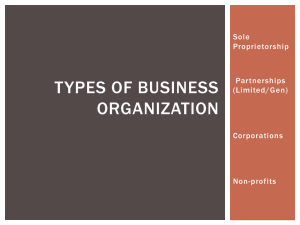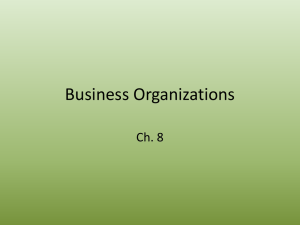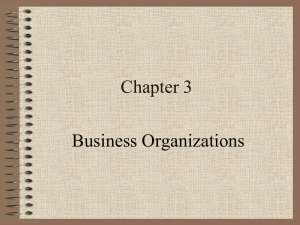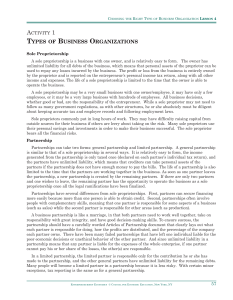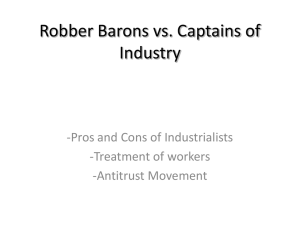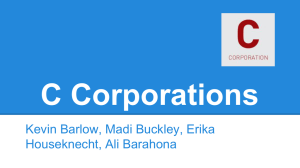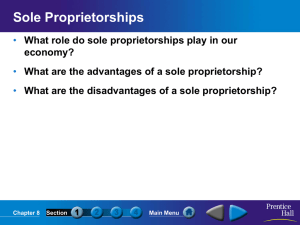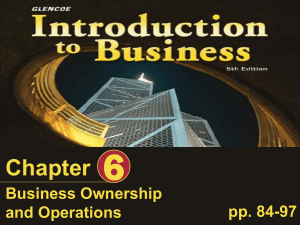01-PP-Business Organizati... - Cornerstone Charter Academy
advertisement
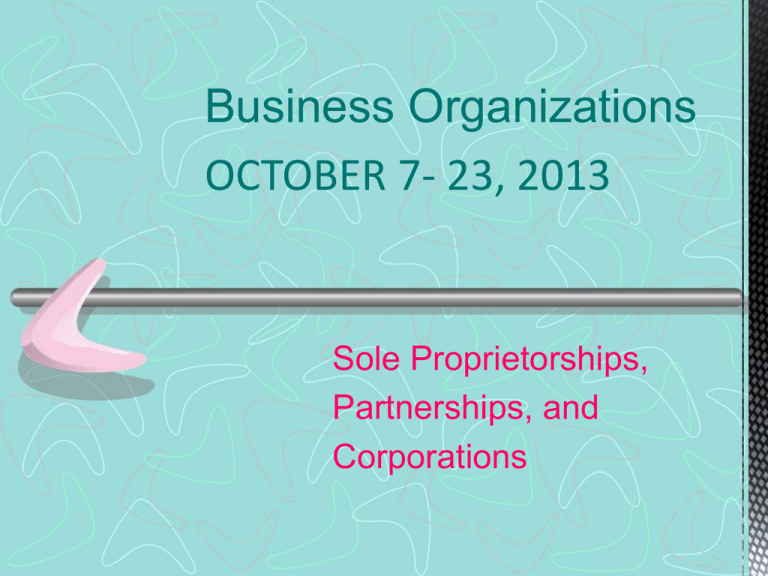
Business Organizations OCTOBER 7- 23, 2013 Sole Proprietorships, Partnerships, and Corporations Business OrganizationsOctober 7, 2013 •In the U.S., many important decisions are made • • by economic institutions-persons and organizations that use or represent the factors of production. One of the major economic institutions is the: Business Organization is a profit-seeking enterprise that serves as the main link between scarce resources and consumer satisfaction. Business Organizations •There are three main forms of business organizations: sole proprietorships, partnerships, and corporations. Students will be working in their groups to complete their Business Organization Projects. How do Business Organizations Influence the US Economy? Students will each get an Econ Book from the bookshelf, and construct a 3 column T-chart providing details of each type of business organization. 1. Sole Proprietor 2. Partnership 3. Corporation On the back of their paper, students will create a Venn Diagram, depicting the similarities and differences of each. WHAT ARE THE 3 Types of Business Organizations? Which do you think is the most beneficial? Why? After submitting your Freak Paper, We will continue watching the documentary. COULD YOU OWN or START YOUR OWN BUSINESS? Students will take a short quiz to find out! http://money.cnn.com/quizzes/2006/fortune/start_business/ I. Sole Proprietorships Sole Proprietorships •A Sole Proprietorship is • • a business owned and run by one person. This is the most common but smallest sized business. Sole proprietorships today account for about 72% of all businesses but only 5% of all business sales. Sole Proprietorships Strengths •1. Ease in which it can be started. •(Run out of home, mow lawns, lemonade stand.) •2. Ease of management. •(Decisions made quickly by the owner.) •3. Keep all profits. •(There may be losses, but there may be Sole Proprietorships Strengths •4. Does not pay business income tax. •(Owner pays personal income tax on profits.) •5. Be your own boss. •(Psychological, personal satisfaction.) •6. Ease of getting out. •(Simply stop offering goods and Sole Proprietorships Weaknesses •1. Unlimited liability •(Owner is personally and fully responsible for all loses and debts of the business.) •2. Difficult in raising financial capital. •(It takes a lot of money to start a business, banks are hesitant to lend.) •3. Not big enough to operate efficiently. •(Need enough capital to pay for labor and Sole Proprietorships Weaknesses 4. Limited managerial experience. (Owner may have to hire others to do sales, marketing, or accounting.) 5. Do not offer fringe benefits to employees. (No paid vacation, sick leave, retirement, health insurance.) 6. Limited life. (If the owner dies, quits, or sells, the firm • • • • • • II. Partnerships Students will read the following article:http://www.sba.gov/content/entrepreneurship-you Upon completion of Reading, Students will write a paragraph describing whether or not they could run a business and why? In order to start a business, you need to have something to “sell”, be it something tangible, an experience, or idea. Students will watch Ted Talk on Joseph Pine: What consumers want. Please draw the chart on Economic Change What is more beneficial? Students will read article from Forbes Magazine: http://www.forbes.com/sites/actiontrumpseverything/2012/09/1 9/franchisees-are-entrepreneurs-let-the-debate-begin/ Students will watch a Ted Clip, on the history of the Franchise. https://www.youtube.com/watch?v=Ie8qJuXYN7w After Clip, students will utilize ECON books to create a t-chart comparing the franchise and a start-up. What is more beneficial, running a business by yourself or with a partner? WHY? Partnerships •A partnership is a • • business owned by two or more persons. This shares many of the same strengths and weaknesses as a sole proprietorship. Partnerships represent about 8% or all businesses and Partnerships Types of Partnerships •1. General Partnership-all partners are responsible for the management and financial obligations. •2. Limited Partnership-at least one partner is not active in running the business. Partnerships Forming a Partnership Articles of partnership are legal papers drawn up to specify arrangements between partners. These papers state ahead of time how profits or losses are divided. Limited liability means investor only responsible for the size of his or her investment. It may also state the way future partners can be taken into the business and the way the • • • • Partnerships Strengths 1. Ease of establishment. 2. Ease of management (Each partner has his or her strength.) 3. Lack of taxes 4. Easier to acquire financial capital. (Better chance of a bank loan.) 5. Larger size makes it more efficient. 6. More easily attracts top talent because they can offer more fringe benefits. • • • • • • • • Partnerships Weaknesses 1. Fully responsible for other partners. (One partner can cause a firm to suffer huge losses.) 2. Limited life (If one partner ceases to exist, it must go through a legal change.) 3. Potential conflict between owners. • • • • • STUDENTS WILL UTILIZE THE REMAINDER OF THE CLASS TO WORK ON PROJECT. Students will watch: https://www.youtube.com/watch?v=Pin8fbdGV9Y III. Corporations Corporations •A corporation is a form of • • business organization recognized by law as a separate legal entity having all the rights of an individual. Corporations can buy and sell property, enter into contracts, and can sue or be sued. Corporations make up 20% of all businesses and 87% of Forming a Corporation Incorporate – to form a corporation Business must ask the state or national government permission. If approved, a charter is granted. The charter states the company name, address, purpose of • • • Forming a Corporation •A charter specifies the number of shares • • • of stock, ownership parts of a firm. These are sold to investors called stockholders or shareholders. The money is then used to set up the corporation. If a corporation is profitable, it may issue a dividend, a check representing a Corporate Structure •After an investor purchases stock, he or she becomes an owner and has certain ownership rights. •The rights of ownership depends on the type of stock. •1. Common Stock- usually receives one vote for each share of stock owned. •The vote is used to elect a board of directors, who direct the corporation’s business. •2. Preferred Stock-nonvoting owners who are Corporate Structure BUSINESS ORGANIZATIONS UNIT- Analysis of a Corporation What is a Corporation? Why is it beneficial to today’s Economy? Students will watch the following Video: https://www.youtube.com/watch?v=wtMORWO5h9Y Corporations Strengths 1. Ease of raising financial capital. May issue bonds, money given to a Corporation as a loan. They mature at a certain date with a set amount of interest. 2. Hire the best talent available. 3. Limited liability. (The corporation, not the owners are responsible for its debts and obligations.) • • • • • Corporations Strengths 4. Unlimited life. (Business exists even when ownership changes.) 5. Ease of transferring ownership. (Simply sell the stock.) Corporations Weaknesses •1. Difficult and expensive to gain a charter. •(Attorney fees, filing expenses; can range from a few hundred to several thousand dollars.) •2. Owners have little say in running business. •3. Expensive taxes on profits. Microsoft Corporation is a computer industry giant. Its operating systems run more than 90 percent of the personal computers in the world. When Microsoft integrated its newest operating system with its own Internet software, other software firms cried foul. They claimed that Microsoft was seeking to use its control of operating system software to gain control of the market for application programs. Was Microsoft becoming a monopoly? The Justice Department and many states filed antitrust suits against Microsoft. Cartoonists took note. STUDENTS WILL ANALYZE AND ANSWER THE FOLLOWING QUESTIONS: http://teachers.sduhsd.k12.ca.us/sfisher/AP%20Economic%20Resources /Economic%20Cartoons.pdf Bellwork 10/18- Students will work in 8 Groups, analyzing business decisions and determining which business organization is best suited for the scenario. Client 1: Elise MacMillan and her brother Evan co-founded The Chocolate Farm in Englewood, Colorado, in the late 1990s. Client 2: Milton Hershey broke ground for his chocolate factory near Lancaster, PA in 1903. It was the beginning of what would become Hershey Foods Corporation . Client 3: Forest Mars invited Bruce Murrie, an investment banker and son of the Hershey company president, to be his partner in M&M Ltd. The M&Ms we still eat today were first sold to the public in 1941. The letters in "M&M" stand for Mars & Murrie. Eventually, Murrie left the business but Forest Mars became the owner of Mars, Inc. Client 4: Wally Amos launched the Famous Amos Cookie Company in a Hollywood, CA storefront on Sunset Boulevard in 1975. Students have the option to either, work on their project or study for their Midterm. Midterm- Oct. 22nd Project- Oct. 23rd
